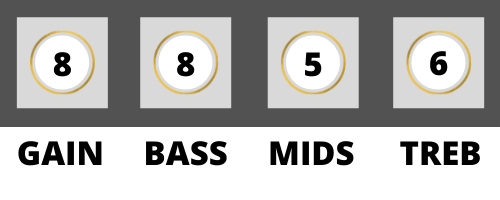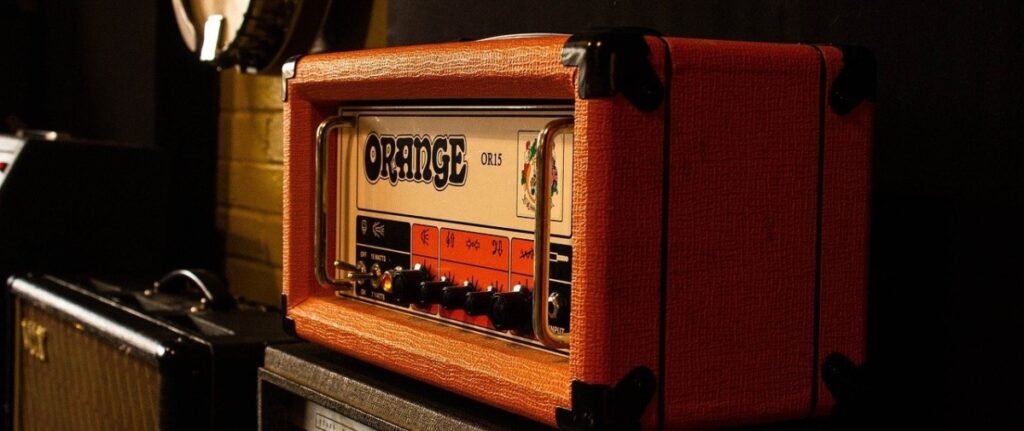Slipknot’s iconic heavy metal guitar tone is one that many guitarists want to emulate. However, sounding like Jim Root and Mick Thomson can be a bit of a challenge. In this article, I’ll guide you through the process of setting up your amplifier’s settings so you can sound as close as possible to Slipknot on the electric guitar.
Quick Guide to Slipknot Amp Settings
To sound like Slipknot on the electric guitar, start with the following settings:
- Gain: 8
- Bass: 8
- Mids: 5
- Treble: 6
The example settings above are just intended to be used as a starting point and will likely need adjusting based on the song you’re trying to play and your rig. Unless you are using the exact same equipment as Slipknot for a particular song, it’s almost impossible to sound exactly the same.
However, I’ve created this article to guide you through the process of setting up your amp to achieve the closest possible tone with your setup.

The Basics
Before we jump into some of Slipknot’s most popular songs, let’s take a look at the settings which underpin their tone. This involves looking at the following three components:
- Gain
- EQ
- Effects
In the most basic sense, Slipknot’s tone comes from high gain and high bass settings to give it a very heavy and full sound. However, it’s not quite as simple as cranking these settings, so let’s take a look at them individually.
Gain
Slipknot use a lot of gain to achieve their tone. The setting you’ll need depends heavily on the type of amp you own. If you own a solid state amp (most reading this will), then you’ll want to start with this on around 8 to begin with. If you own a tube (valve) amp, then it will really depend on when the distortion kicks in, for most amps this will be at least 3/4 the way up.
However, a caveat does come in here (regardless of if you own a tube or solid state amp). Different amps have different maximum gain capabilities. An Orange amp for example will often sound more distorted on the maximum gain setting compared to a Fender amp.
Alternatively, you may not want to use your amp for the distortion. If you have a pedal and you don’t think your amp’s distortion delivers enough power and clarity, then it’s time to plug it in. If you are using a distortion pedal, then it’s best to keep the settings on your amp as clean as possible and control the gain only using the pedal. This often results in a clearer tone.
EQ/ Tone (Bass, Mids, Treble)
Most amps have an EQ section which will either utilise a single control (called EQ or tone usually), or separate bass, mids and treble controls.
It’s a good idea to use the bridge pickup and make sure your guitar’s volume and tone controls are on maximum before continuing to adjust the EQ controls.
The bass control for most Slipknot songs should be relatively high, so start with this on 8 to begin with. If it sounds too muddy and loose, turn it down. However if the tone needs more beef, then you can crank it up.
The mids control should be fairly moderate to start with, so go for around 5 to begin with. If you are using single coil pickups, then this setting may need to be a bit higher.
The treble control adjusts the high-end frequencies so affects how bright and crisp the tone is. It’s a good idea to start with this on 6 to begin with to provide enough definition, but without it sounding harsh.
However, the setting your treble control needs to be on will depend on a few factors. For example, if you are using passive (instead of active pickups), then you’ll often need to turn the treble up more. However, if you are using single coil pickups (instead of humbuckers), then you may need to turn the treble down.
If your amp has a single EQ control, then set it so it favours the bass frequencies slightly. For most amps, this means it’ll be around 1/4 the way up (setting 2-3).
Some amps also have other controls such as presence and contour. Check out my complete guide to amplifier controls to learn how to adjust these controls and many more to get the best settings possible.
Make sure you also check out the brand-specific amp controls guide which is relevant to you, to get the most from your rig:
- Fender Amp Settings
- Marshall Amp Settings
- Boss Amp Settings
- Orange Amp Settings
- Line 6 Amp Settings
- Vox Amp Settings
Effects Pedals
In most cases, you won’t need to use many, if any, built-in amp effects or effects pedals. However, the following pedals may be useful if you have them:
- Distortion: this can be used instead of the gain on your amp if you need more power and clarity.
- Compression: this will help to improve sustain.
- Noise-gate: this will help to reduce the amount of feedback created as a result of using so much gain.

Sounding like Slipknot isn’t just about your amp settings, it’s about your skills too.
Check out this 14 day free-trial for Guitar Tricks to access over 11,000 lessons and 1000 songs to become a better player today.
Amp Settings for Popular Slipknot Songs
Now that’s we’ve been through the basics, let’s look at some example amp settings for some of Slipknot’s most popular songs. These are not the exact settings used by Slipknot, as I said at the start of this guide, it’s impossible to provide example settings which suit everyone’s rig, so the following should just be used as a starting point. Don’t worry if they don’t sound quite right yet, the next section will address some common issues and how to fix them.
Duality Amp Settings
- Gain: 8
- Bass: 9
- Mids: 5
- Treble: 6
Before I Forget Amp Settings
- Gain: 9
- Bass: 8
- Mids: 5
- Treble: 7
Psychosocial Amp Settings
- Gain: 8
- Bass: 8
- Mids: 5
- Treble: 6
Unsainted Amp Settings
- Gain: 9
- Bass: 9
- Mids: 6
- Treble: 6
The Devil in I Amp Settings
- Gain: 7
- Bass: 8
- Mids: 6
- Treble: 7
Wait and Bleed Amp Settings
- Gain: 7
- Bass: 7
- Mids: 4
- Treble: 6
I’ve also made an article with example amp settings for over 40 popular guitar songs here to help you sound more like your favourite players.
Common Issues
If you’ve used some of the example amp settings and it still sounds a little bit off, then this section will help fix it. I’ve listed some common problems you might encounter when trying to sound like Slipknot, and a list of fixes.
With each problem, there are multiple suggestions to fix it. They are all listed in order of priority and you should make one adjustment at a time and listen for the difference. It might be that you only need to make one tweak to get the tone spot on.
Try not to make very dramatic adjustments as well. Altering by 2-3 should be enough for most settings to hear a significant difference. Take your time, it’s the best way to get good results!
Muddy and Muffled Tone
- Make sure you are using the bridge pickup and that the guitar’s volume and tone controls are on full
- Increase the treble
- Decrease the bass
Check out my guide on how to fix a muddy amp for more causes and fixes.
Not Enough Sustain
- Increase the gain
- Increase the bass
- Increase the mids
- Use a compressor pedal
Tone Sounds Weak Instead of Punchy
- Increase the mids
- Increase the gain
- Increase the bass
- Use a distortion pedal
Too Much Feedback
- Decrease the gain
- Move the guitar and amp as far away from each other as possible
- Position the amp in front of the guitar rather than behind it
- Use a noise-gate pedal to reduce feedback
Frequently Asked Questions
What amps do Slipknot use?
Slipknot use a variety of amps, with Jim Root primarily using Orange amps such as the Dark Terror and Rockerverb, whilst Mick Thomson mainly uses a Rivera KR7.
What electric guitars do Slipknot use?
Slipknot’s Jim Root primarily uses a Fender Signature Telecaster with EMG pickups and Mick Thomson mainly uses a Jackson Soloist with Seymour Duncan pickups.
Here are some more articles you might find useful:
